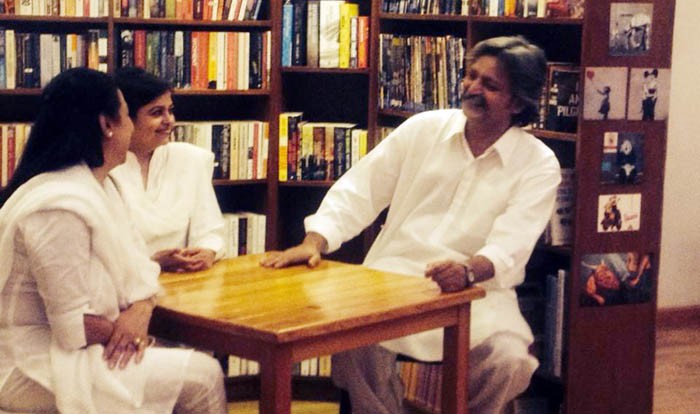
With dramatic readings, Zambeel is reviving the ancient tradition of ‘dastangoi’

Eons ago, people had all the time in the world to nurture the art of listening. Long before the printing press was invented, and later the worldwide web that transmuted into e-books and digital books, narratives were recited and literature was spoken. The Hamzanama, or the Dastan e Ameer Hamza, was one of the many such works of literature that told fantastic tales of the many ventures of Ameer Hamza. Ameer Hamza’s companion Amar Ayyaar (also called Umro Ayyaar) had a bag called a Zambeel that contained all that that is in the world but the Zambeel would never be filled. The magical Zambeel, hence, could produce objects that would be core subjects of many a dastan.
But that was then and this is now. Princess Scherezade could no longer have bartered her life for tales she told as part of her Alif Laila repertoire, for no one has a thousand and one seconds to spare, let alone A Thousand and One Nights. Yet, there is a present day version of the Zambeel that has been successful in its attempts at reviving the tradition of dastangoi, or storytelling as we may call it today. Enter the Zambeel Dramatic Readings, and see a modern day semblance of this ancient art. For even if for a brief period of time, this will take you into a world where Urdu literature is read out to you the way it should be.
Zambeel Dramatic Readings came into being in early 2011 when a group of three friends -- Asma Mundrawala, Mahvash Faruqi and Saife Hasan -- was requested by a friend to read out a story in a gathering. "We embellished it with music. The response was what made us initiate and realise Zambeel," says Mundrawala, a visual artist and theatre practitioner who is one of the key people behind this initiative. Zambeel Dramatic Readings was founded with a view to present texts from Urdu literature in a dramatised form to a live audience, and has mainly targeted adult audiences, but has also ventured into readings for children during the last three years.
"We aim to present texts rendered in their dramatised form, to create a dynamic collusion between literature and performance. Referencing traditions of storytelling and the contemporary form of the radio play, our works traverse time and geographical boundaries to interpret and enliven narratives through sound and recitation," says Mundrawala.
Mahvash Faruqi is an educator with a background in theatre, and Saife Hasan is a performing arts practitioner particularly known for his acting.
What begun with writings from Ismat Chughtai’s rich repertoire, the group has since inception presented many projects comprising stories in both English and Urdu by authors that include Quratulain Hyder, Saadat Hasan Manto, Masood Mufti, Afsan Chowdhury, Raihana Hasan, Ashraf Suboohi, Asif Farrukhi, Munshi Premchand, Faiz Ahmed Faiz and Naiyer Masud. Of late, more contemporary writers’ works are also being included into the repertoire, like Asad Muhammad Khan, Ghulam Abbas and Zamiruddin Ahmed.
"Zambeel readings have reintroduced the cultural tradition of dastangoi. The selection and the delivery has the audience in raptures," says journalist and literature aficionado Afia Salam. "In an age where the purists were fearful of the fading away of correct pronunciation and nuanced delivery of Urdu, the Zambeel team has bridged the gap between the older generation and younger one by introducing this genre to them."
Mundrawala affirms that while initially the audience mainly comprised only of Urdu literature enthusiasts, over time the younger generation has also begun frequenting the readings. "We now have audiences who have read the stories and also those who have not read the stories. The younger lot may not understand Urdu with facility yet they come."
Fahad Naveed, a visual artist and long form writer, is one of Zambeel’s young audience members. "I’ve been following Zambeel for a few years now and greatly admire their work. Their readings make Urdu literature approachable and exciting for varied audiences. I’m particularly drawn in by the group’s use of sound; often sitting on a table, they are able to transport the audience with just their dialogue delivery and a few sound effects and audio cues," he says.
Also reviving the tradition initiated by grandmothers of the region to read out stories to children, Zambeel now also caters to a younger audience, enthralling both parents and children. One such fan of these readings is Saima Harris, an optometrist and mother of a seven-year-old.
"Our experience of Zambeel’s dramatic readings was Tipu aur Jaadu ki Bayl, an Urdu narration of my son’s favorite Jack and the Beanstalk. The audience was predominantly the English-speaking ‘Burger’ primary-schoolers of Karachi (who tend to shy away from the Urdu language), and their very keen parents," she says, adding the dramatic and interactive Urdu narration, interspersed with toe-tapping melodies, brought a traditional English childhood classic to life. "It is a step aside from the all-important but solitary reading from a book or the mind-numbing watching on a screen. There is immeasurable potential here to both entertain and educate."
Artist Rumana Husain, who is known for solo readings for children and production of quality Urdu literature for children, says it is rare nowadays to have literary readings in the country read in a dramatic fashion, and is all praise for the initiative.
Zambeel performers imbue texts with a poignant expressive quality and perform narratives that are supported by a soundscape, enriching the aural experience of the audience through sound and recitation, explains Mundrawala. "While we are three core members, we have had many actor friends work with us by lending their voice and acting talents to our projects. Their contributions have enriched our works and we are privileged to have had so many actors, as well as designers, artists, and musicians collaborate with us."
The team has recently initiated an audio platform of readings once a month on the YouTube channel, Zambeelnaama.